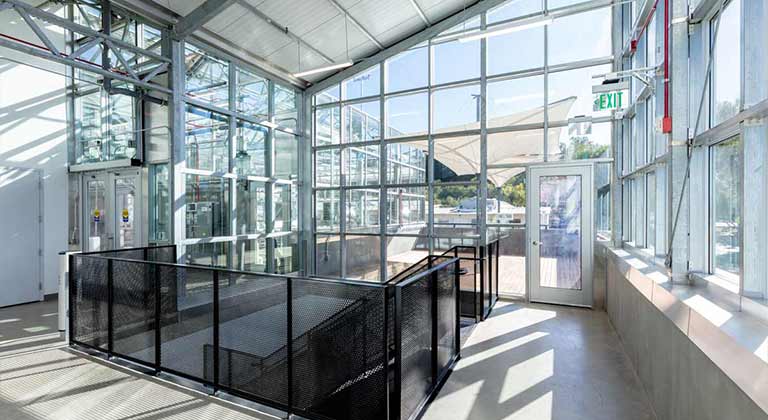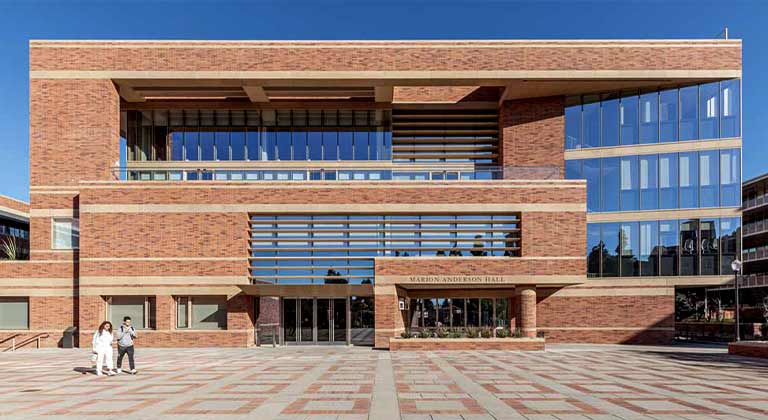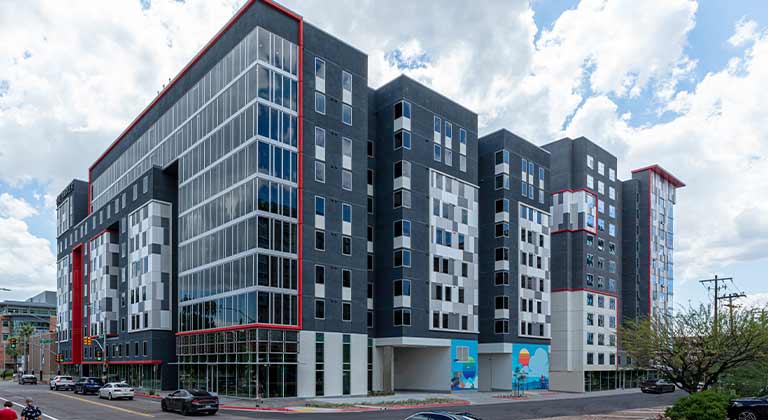Curtain wall systems are a key factor in modern building design. They can provide a range of benefits for your project, such as:
- Weatherproofing a structure
- Reducing sway in tall buildings
- Allowing more light to enter the building
- Improving overall thermal efficiency.
The most common types of curtain wall systems used in construction are stick-built, unitized, metal or aluminum curtain wall systems, and structural glazing wall systems. The various types of curtain wall systems meet specific performance and design criteria and offer a range of features and benefits that make them an integral part of contemporary architecture.
Here is an overview of the most typically-used curtain wall systems installed by glaziers, along with their features and benefits.
The Four Most Common Types of Curtain Wall Systems
Understanding these popular methods of building curtain wall systems helps inform decisions based on your project requirements and preferences.

1. Stick-Built Curtain Wall Systems
The stick-built curtain wall system is a construction method that entails assembling individual components, piece by piece, at the job site. This type of curtain wall system is best utilized for:
- Low-rise buildings
- Confined areas where exterior access is feasible for reaching higher elevations
- Reduced shipping costs
- On-site customization and adjustments.
It does require additional equipment at the project site, however, such as scaffolding and cranes. Installation of this type of system requires a substantial investment of time and labor.

2. Unitized Curtain Wall System
Unlike stick-built systems, unitized systems are comprised of framing and glass panels that are prefabricated, pre-assembled pre-glazed. They eliminate the need to install each component individually at the project site. It’s often the system of choice in high-rise buildings. Some of the benefits of using this method to build a curtain wall include:
- Timesaving
- Faster construction
- Assure high-quality construction before shipping to the site
- Efficient installation process, with reduced on-site labor costs
- Less on-site equipment, such as cranes or scaffolding.
A few caveats include the need for a temporary hoist or mini crane during installation, and more substantial shipping costs (compared to stick-built components) due to the greater unit sizes, and higher degree of protection required during transportation.

3. Metal or Aluminum Curtain Wall Systems
One of the most common materials used in wall systems includes aluminum framing, steel, brick, and glass. While the benefits of metal curtain wall systems depend on the type of metal used, some include:
- Greater free spans
- More freedom for daylight designs
- Reduces the quantity of vertical and horizontal mullions
- Supports heavier weights of glass like double- or triple-glazed units
- Reduce long-term maintenance costs.
Experts advise against using aluminum curtain wall systems that depend on the seals between glass units and frames and frame members in order for them to operate efficiently. These systems, referred to as face-sealed barrier walls, eventually may pose reliability issues.

4. Structural Glazing Wall Systems
Structural glazing wall systems are versatile. They provide a wide range of budget and design options while providing aesthetically pleasing results.
The versatility allows this type of curtain wall system to use:
- Monolithic glass
- Laminated glass
- Dual-glazed
- Triple-glazed insulated glass units (IGUs)
The supporting structure may incorporate horizontal or vertical aluminum mullions or alternative materials such as glass mullions, steel blades, cables, or stainless-steel rods. Depending on the system, extruded silicone gaskets or wet-sealed silicone may be used for the interior and exterior.

The Advantages of Installing Curtain Walls Systems in Buildings
Curtain wall systems are a popular choice for modern buildings, offering a range of advantages over traditional construction methods. Curtain wall systems create a contemporary appearance while providing excellent energy efficiency and weather resistance. In addition to their aesthetic appeal, several types of curtain wall systems can also enhance occupant comfort and reduce cooling and heating costs. Here is a review of some of the advantages of curtain wall systems.
Weather Proofing
Curtain walls provide an additional layer of insulation and protect against weather elements, preventing air and water from entering the building.
Reduction in Sway
For taller buildings, curtain walls are an excellent choice because of their ability to withstand high winds. They distribute the kinetic force across their frame, which reduces overall sway. Additionally, their wind resistance provides a level of acoustic insulation and soundproofing.
More Natural Light
Curtain walls provide an effective means of bringing in natural light and making the building’s interior appear bigger and brighter.
Improvement of Thermal Efficiency
Glass panels used in curtain walls can be glazed to reduce UV light and stabilize the interior temperature, resulting in higher thermal efficiency. This, in turn, can reduce energy costs over time.

The Role of Glass in Curtain Walls and Its Impact
Incorporating a range of glass techniques in curtain walls provides distinct advantages in terms of energy efficiency, sound insulation, structural stability, and aesthetic appeal. Below are a few glazing methods worth considering and their relative potential impact.
Pressure Plate Glazing
This system involves installing the glass and infill panels from the exterior using dry gaskets. The outer layer of gaskets is compressed against the glass by fasteners that secure a continuous pressure plate. A snap-on mullion cover is then placed over the plate. While this system works well, it may experience leaks at corners or any joints that use dry gaskets.
To improve performance, better options would be to use four-sided gaskets at an additional cost, or wet sealants to provide a concealed interior toe bead or exposed interior cap beads.
Pressure plate glazing is the easiest way to create an air barrier between adjacent construction and the air barrier of a curtain wall system.
Interior Dry Glazing
This glazing system offers a cost-effective solution for installing glass and infill panels from within the building without expensive scaffolding. The frame is securely fixed with exterior dry gaskets, and the top interior mullion has a removable stop for easy access.
The installation involves sliding the glass unit into a deep glazing pocket on one side, then smoothly transitioning it to the opposite side before dropping it into the glazing pocket. This technique, (commonly known as “jiggle” or “wiggle” glazing), may slightly reduce performance due to metal-to-metal joints. Its performance can be enhanced by using wet sealant heel beads.
Structural Silicone Glazing (SSG)
This method uses a bead of silicone to attach the glass to the frame, with outer weather seals added for extra protection. Structural silicone glazing is used for four-sided SSG, while two-sided SSG can be used with a pressure plate or wiggle glazing for field installation.
Butt-Glazing
Butt-glazing is a technique that doesn’t use a mullion behind the joint. It depends entirely on a sealant, usually silicone, between glass units to create a flawless barrier seal.

Glass and Its Impact on Curtain Walls
Glazing is a common construction method used in different types of curtain wall systems due to the impact it has on several components. The use of glass in these systems can reap some environmental and other benefits we’ll discuss below.
Structural Integrity
When glazing is integrated into the structure of a building, it typically involves using large glass panels that support the structure. This is known as structural glazing, allowing for massive glass installations with minimal obstructions, enhancing views and bringing in maximal levels of light.
Sound Control
Using various window thicknesses, STC ratings, panes, and materials, the use of glass can effectively minimize disruptive noise from the outside that would otherwise enter the building.
Energy efficiency
Curtain wall systems can range from single-skin to triple-skin glazing systems, allowing for high-energy efficiency. By creating a system that retains warmth during the winter or repels heat in the summer, builders can optimize the energy efficiency of a building.
Aesthetics
Glazing improves the appearance and functionality of a space through design elements such as tinting, reflectiveness, opacity, and low-emissivity coatings.
Understanding Curtain Wall System Design Considerations
As an architect or designer working on different types of curtain wall systems, it’s important to consider several factors before deciding on the type of curtain wall system for your project.
The Budget
Before exploring possibilities in structural wall systems, it’s important to consider the provided budget. To prioritize design intent, understanding the budget is crucial for choosing the right system.
Structural Integrity
Calculating proper wind load conditions for your curtain wall system is vital. Not doing so accurately is one of the most common errors that lead to curtain wall failures. It’s equally important also to consider:
-
- Movement capabilities of the curtain wall
- Weather tightness and weather conditions
- Sound control
- Energy efficiency
- Thermal expansion and contraction
- Dead load
- Seismic activity
Giroux Glass Will Guide You through Your Curtain Wall Project
Curtain wall systems can be comprised of a range of methods, from stick-built, unitized, metal or aluminum, to structural systems – and of hybrid versions incorporating any or all of these types. Curtain walls are an essential part of modern building design, providing benefits that include:
- noise reduction
- energy efficiency
- modern aesthetics
- structural integrity.
The type of curtain wall system you select can depend on your budget, design, wind load requirements, environmental conditions, and aesthetics. Consulting with the expert glazers at Giroux Glass Inc. can guarantee the best possible outcome.
Giroux Glass is renowned for its expertise in identifying, preventing, and resolving issues related to glass, glazing, curtain wall systems, and other areas. Contact us for more information today.